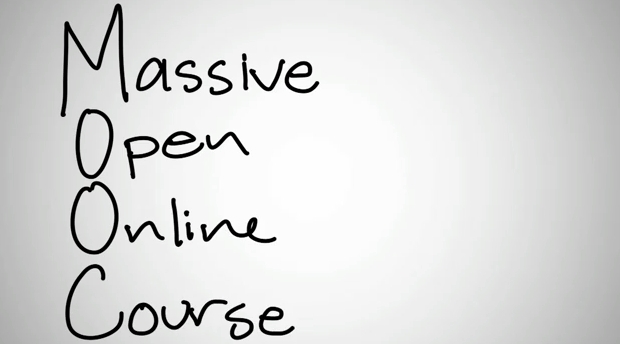How To Convert Large Group Classes to Massive Online Courses
I think the easiest way to illustrate my breakout is to explain it in the context of a course I took at Brigham Young University: American Heritage. It, like other courses, was taught in a lecture hall with about 800 students in each section, and 3,000 for one professor.
You may also find the following articles useful:
- What I'm learning from Harvard: A MOOC story - Part 1
- What I'm learning from Harvard: A MOOC story - Part 2
- What I'm learning from Harvard: A MOOC story - Part 3
- What I'm learning from Harvard: A MOOC story - Part 4
- Converting Large Group Classes to Massive Online Courses
- The Rise and History of MOOCs - Infographic and Prezi Presentation
What is a MOOC?
Written and Narrated by Dave Cormier. Video by Neal Gillis Researchers: Dave Cormier, Alexander McAuley,George Siemens, Bonnie Stewart. Created through funding received by the University of Prince Edward Island through the Social Sciences and Humanities Research Council's "Knowledge Synthesis Grants on the Digital Economy"
Instruction:
Two days a week, the students would attend lectures. They would herd us like cattle into an auditorium, and the celebrity professor would take the stage, tell a joke or two, and then tell us about the history of the American nation. It wouldn't have mattered if there were 600 of us or 600,000 of us, because there was basically no time for questions, and no interaction or engagement with the students - just an excellent lecturer with a real talent for instruction.
Coaching:
After our lecture-room experience, we'd in groups of about 15-20, led by a teacher's assistant (TA). The professor had met with all the TAs and told them what was to happen in each group, and the TAs would interact with the students on a more individual basis. In the groups, we would discuss what was taught in lecture and study for the quizzes and tests together.
Assessment / Feedback:
Each group’s TA was in charge of giving us quizzes, assigning us essays, and preparing us for tests, all of which came from the professor. The tests were graded electronically, and the TA graded the quizzes and essays according to the rubric the professor had created. If we didn't like our grade on an essay, we could theoretically appeal to the actual professor, but hardly anyone did. Most college-graduates are probably quite familiar with the large lecture model or something similar, and I the majority would probably vouch for its effectiveness for many subjects. Let's consider the conversion of these three aspects into the world of MOOCs.
Instruction:
MOOCs really shine at scaling instruction; it is their sweet spot. Recorded video lectures are in many ways better than live lectures: Students can watch them whenever and wherever they want, they can re-watch parts, they can pause playback and lookup information while they receive instruction, and they can even watch at accelerated speeds. MOOCs can correlate instruction to study materials better, because they can cut up the instruction into digestible pieces and put the videos in-line with the readings.
Coaching:
Despite the effective instruction aspect, many MOOC participants don't get the coaching they need to succeed. Some become confused and dropout or lose interest. Some MOOCs have compensating by allowing for small group breakouts - virtually or physically - and some allow for peer review. These groups typically don't have much connection back to the professor and aren't well integrated with instruction or assessment. Often, they're lacking the organization and leadership that the TA provides in the traditional university course.
Assessment:
Without the TA to assign and evaluate student work, MOOCs rely almost exclusively on computer-graded assessment. Some MOOCs incorporate these directly into the instruction, but most don't assess until after the unit is over in multiple-choice tests. The professor has no direct interaction with students who may be struggling or falling behind, and they often go unnoticed. Some obstacles to creating an effective online learning environment have not yet been overcome. What can be done? Here are my suggestions:
- First,
Incorporate assessment into instruction - As I mentioned, most MOOCs already make their instruction short, easily consumable pieces. So, let's take those and see whether the student understands each concept. If she does, teach her something new. If she doesn't, give her more instruction and examples. Some platforms, like Khan Academy, do this fairly well, but these platforms haven't been implemented into many MOOCs yet. - Second,
create an intermediate tier between the student and the professor. Even though this may create an additional cost structure, the coaching and assessment that can be provided from this layer creates a needed cohesion. Hundreds of tutoring sites, skill exchange, and potentially even volunteer organizations already have people identified with skill sets ready to contribute to this cause, and the availability of capable intermediary TAs makes scaling a possibility. - Third,
tie the loop between the professor, TAs, and students. The same system that evaluates and assesses learners in real-time can easily provide relevant, up-to-date reports to both the professor and the TA for each student. This way, they can identify common difficulties as well as individual weaknesses and learners who need extra help. Also, the professor should communicate frequently with the TAs to ensure that TAs are providing the support needed and evaluating correctly according to established rubrics. The assessment system can quickly identify TAs whose performance is superior or lacking, so the professor can reward or take corrective action with them. In this way, all three groups would be aware of progress, evaluation, and expectations which would solve an awareness and transparency problem that exists even in traditional education.
MOOCs will not completely replace traditional education, just like not every course can be taught in the large-lecture format. They will, however, provide a better education to an audience that otherwise would not have access to it. One platform in the language learning sphere that will serve as this intermediary for all three parties: instructors, TAs, and students is called Instreamia. I'll be using it to teach the first MOOC to implement these principles to teach Spanish, details at www.spanishmooc.com
You may also find the following articles useful:
- What I'm learning from Harvard: A MOOC story - Part 1
- What I'm learning from Harvard: A MOOC story - Part 2
- What I'm learning from Harvard: A MOOC story - Part 3
- What I'm learning from Harvard: A MOOC story - Part 4
- Converting Large Group Classes to Massive Online Courses
- The Rise and History of MOOCs - Infographic and Prezi Presentation









